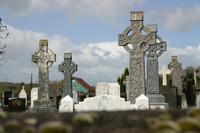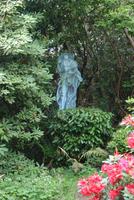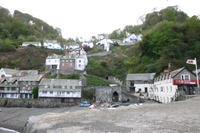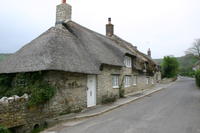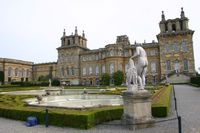
Dingle is a lovely little town where we saw fishermen cleaning their nets. A little bit further on we walked into Dunbeg Promontory Fort, an impressive cliff top promontory stone fort. The fort shows signs of damage due to erosion but is still very impressive. Inside the fort is a circular Beehive hut or Clochan with a square interior. The fort has four outer defensive banks and a souterrain about 16 metres long, leading from the front of the outer defenses to the interior. The fort has been dated to around the 10th century.

Almost directly across the road from Dunbeg are a series of "Ringforts" known as Beehive Huts which have stood there for over 4,000 years. It's hard to imagine that these piles of loose stones have been sitting there that long. They were in habited from ancient times until about 1200 AD. The stones were piled in a downward and outward manner, so as to funnel rain water away from the interior.
We stopped for a coffee at Tig Slea Head and had a browse around the craft goods offered, but managed to resist again! Well a little bit as I think it was here that I bought a necklace and Marie bought some lovely jumpers for May and Jack.
The 'pièce de résistance' is the Gallarus Oratory, dating from 800 AD, it is a perfect example of the boat shaped oratories associated with the Dingle peninsula. It is built without mortar, uses corbel vaulting a technique developed by Neolithic tomb-makers.
 The walls are built of sandstone and are 1.2 metres thick. The east wall has a round headed window. Internally the oratory measures 4.65 metres x 3.1 metres. At the side of the northern wall is a leact and Cross-Slab. The cross-slab stab is 1.1 metres high x 0.3 metres thick and stands at the east end of a rectangular bed of stones. The upper part of the slab is inscribed with an equal armed cross within a circle and the lower part bears an inscription in half uncial script reading, COLUM MAC DINET The workmanship is impeccable, it is unbelievable that this has remained intact for so many years.
The walls are built of sandstone and are 1.2 metres thick. The east wall has a round headed window. Internally the oratory measures 4.65 metres x 3.1 metres. At the side of the northern wall is a leact and Cross-Slab. The cross-slab stab is 1.1 metres high x 0.3 metres thick and stands at the east end of a rectangular bed of stones. The upper part of the slab is inscribed with an equal armed cross within a circle and the lower part bears an inscription in half uncial script reading, COLUM MAC DINET The workmanship is impeccable, it is unbelievable that this has remained intact for so many years.
